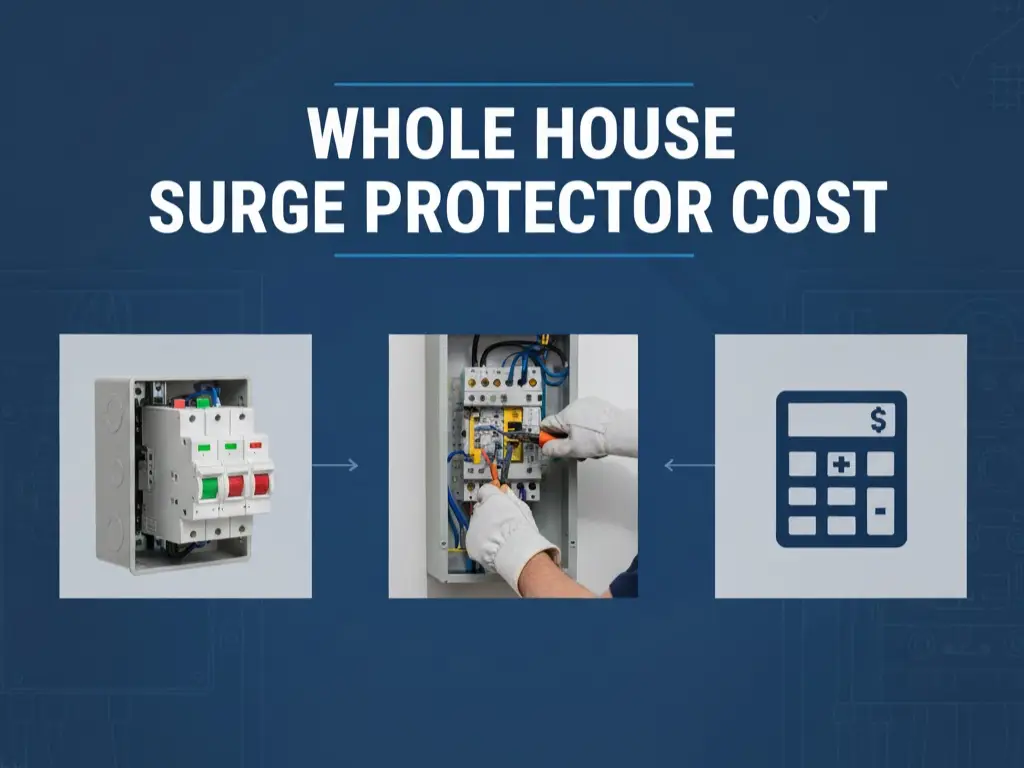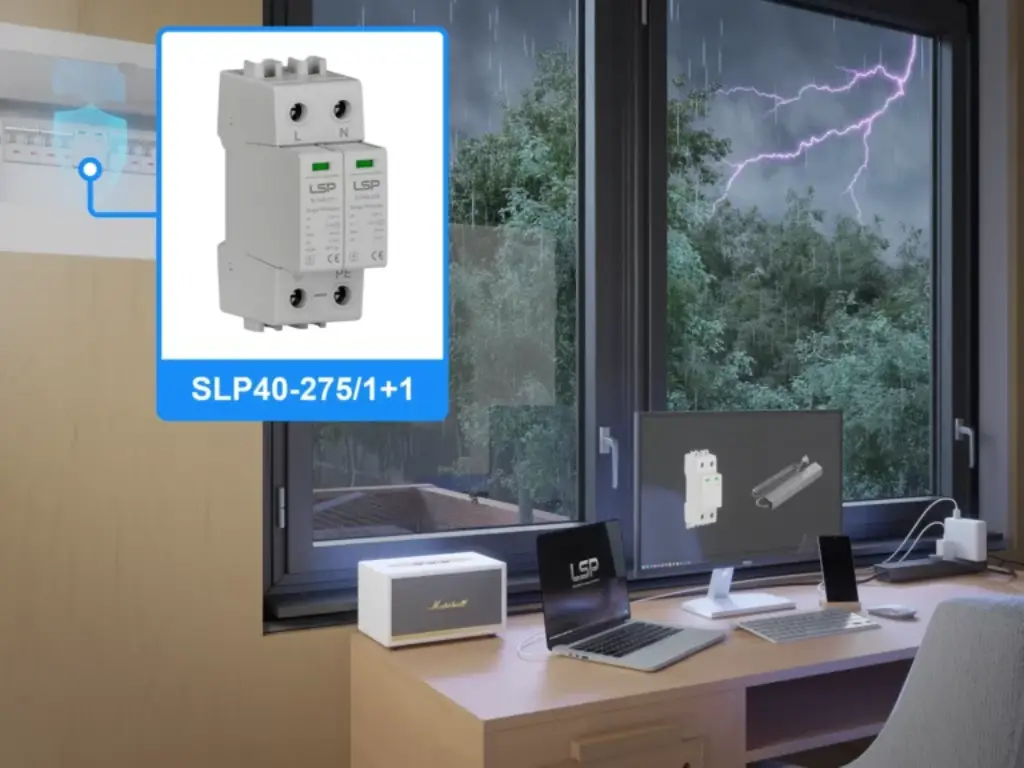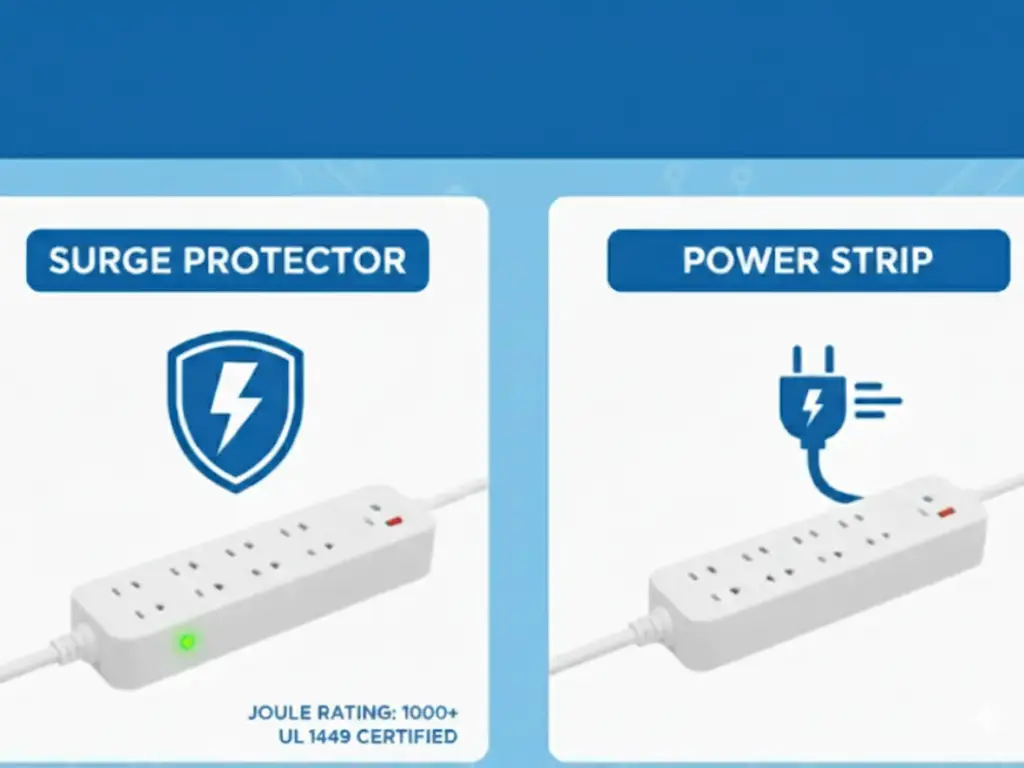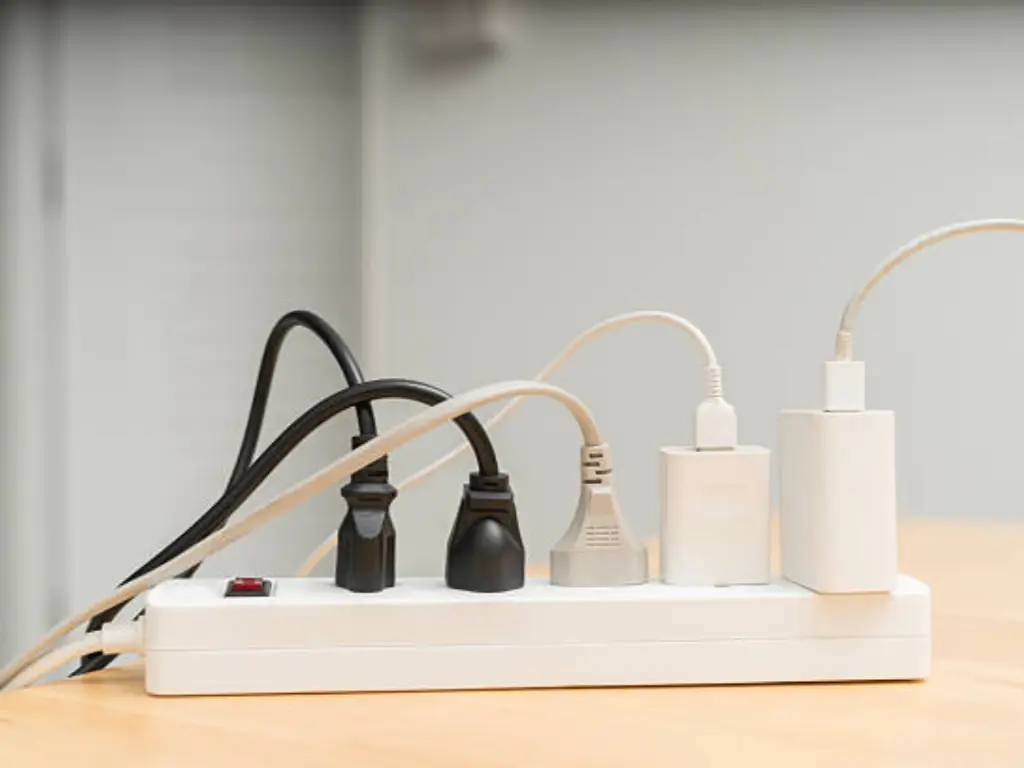In the modern home, a constant flow of electricity powers our daily lives. The television, which is a source of entertainment, the home computer, which contains our work and memories, and the smart appliances that make our work easier—all of these electronic devices rely on a constant, clean electrical current. However, this current is not always stable. Power surges—short, intense bursts of high voltage—are an ever-present, unseen danger that can impair, harm, or even destroy the delicate microprocessors at their core.
Although many of us use plug-in power strips, they are only the last, and often incomplete, step in a proper defense strategy for individual devices. To offer comprehensive protection to your entire home’s electrical system, you need a more powerful solution. The first line of defense should be a device that stands on guard at the very point of power. This is what the Whole House Surge Protector (SPD) does.
This is the ultimate guide to understanding, selecting, and safely installing this critical device. Whether you are an expert DIYer about to embark on a new project or a homeowner who wants to know the worth of this investment, we will take you through the entire process, equipping you with the knowledge to secure the electronic future of your home.
What is a Whole House Surge Protector & Why You Absolutely Need One
A whole house surge protector is one of the most vital surge protection devices you can install. It is connected to your main electrical panel where it monitors the primary power lines of your house. Its sole function is to identify the abrupt, huge over-voltages, or sudden voltage spikes, that characterize a power surge. It responds in microseconds when it detects one, directing the damaging excess electricity safely out of your home’s circuits and into the grounding system.
The necessity of this central surge protection has never been greater. Electrical surges originate from two main sources:
- External Surges: These are the dramatic events most people consider, such as lightning strikes near power lines or problems with the power grid. Although less frequent, they are extremely powerful and can cause disastrous equipment damage in an instant.
- Internal Surges: These smaller voltage spikes are much more frequent, and they are produced within your home on a daily basis. The on and off switching of large appliances such as air conditioners, refrigerators, or clothes dryers generates dozensof these small surges. While a single event might not destroy your laptop, this continuous exposure leads to cumulative damage, gradually impairing performance and reducing the life of your sensitive electronics in the long run.
A whole house surge protectoris the only device that protects against both of these threats. It covers not just your plug-in electronics, but also hardwired devices that you may not think about, including your HVAC system, smart lighting, and other major appliances, ensuring all your connected equipment has better protection. It is not only an investment in one device but also in the durability and dependability of all the electronic parts in your house.
Choosing the Right Surge Protector: Two Main Types Explained
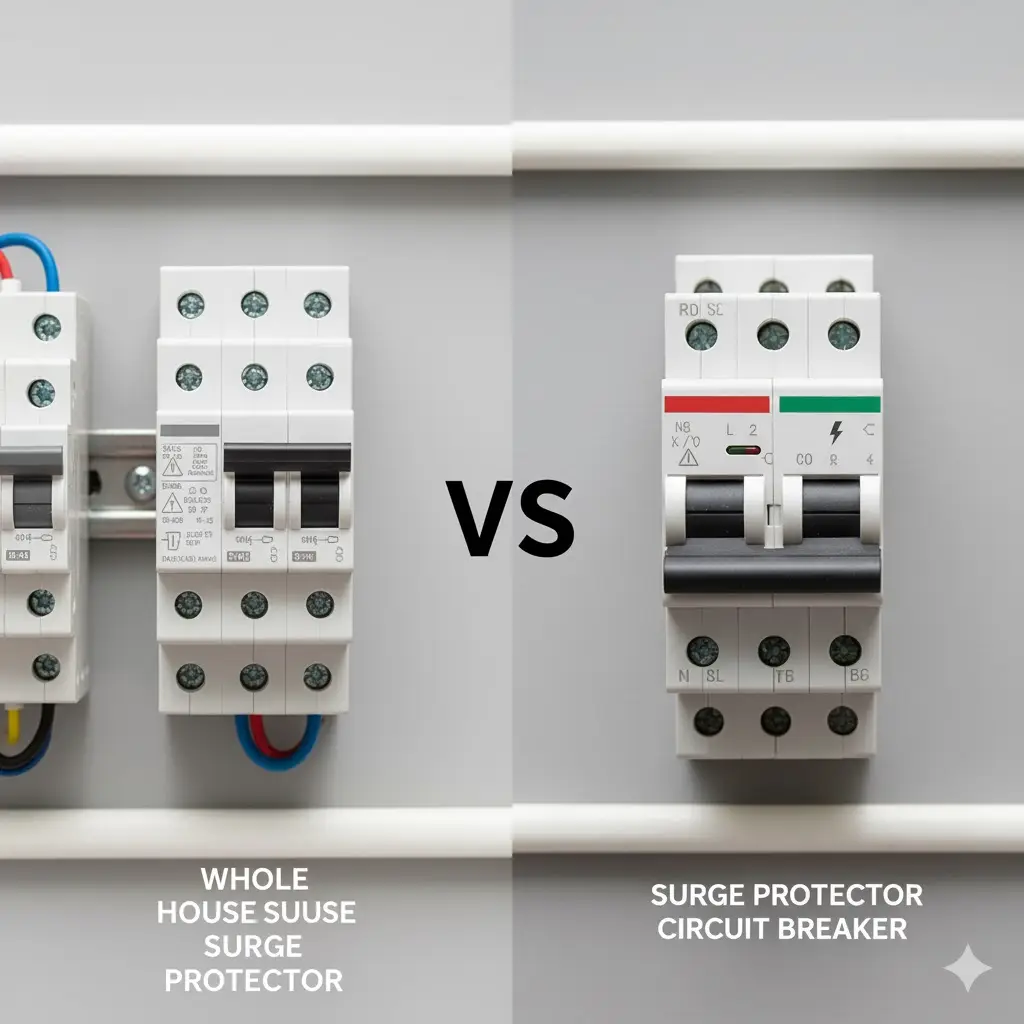
Before you can begin the surge protection installation, you need to choose the right surge protector. There are two main types of whole house protective devices, each having a different installation procedure and benefits. It is important to understand these and some of the key technical specifications.
The two main types are:
| Type | Description | Installation Location & Method | Advantages | Limitations |
| External-Mount Surge Protection Device | The most common type. A small, self-contained box. | Mounted on the side of or inside the breaker panel, connected to a dedicated double-pole circuit breaker. | – Higher surge capacity (kA) ratings – Wide range of models – Available from reputable brands like Square D | Takes up external space; more visible installation |
| Surge Protector Circuit Breaker | Integrated design where surge protection elements are built into the breaker unit. | Clips into two adjacent slots on the bus bar in the panel, just like a standard double-pole breaker. | – Clean, space-saving installation – Easy to install | Fewer model options and typically lower surge capacity ratings compared to external units |
When comparing models, look for the Surge Current Capacity (kA rating). This figure shows how much much energy the device can absorb before it breaks down. While you might see a joule rating on smaller individual surge protectors, the kA rating is the critical metric for whole-house units. A higher joule rating is good for point-of-use protectors, but for the main panel, focus on kA. Also, look for a lower clamping voltage, which indicates the device has a faster response time to stop sudden spikes of excess voltage. To ensure quality and compliance, look for surge protection devices that meet standards set by the National Electrical Manufacturers Association (NEMA),Underwriters Laboratories (UL), and European or international standards such as IEC 61643 or EN 61643.
Why Our SPDs Offer Superior Protection and Peace of Mind
- Fire protection design, 5-year warranty
- Top tier raw materials: MOV from LKD®, GDT from Vactech®, etc.
- 300,000 pcs/year
After understanding the key specifications and types of Surge Protective Devices (SPDs), choosing a reliable one becomes essential. Since 2010, LSP has been dedicated to the research, design, and manufacturing of SPDs, fully aware of customers’ real pain points in installation, performance, and after-sales reliability. With over 15 years of professional experience and complete in-house production capability, we continuously refine our designs so that every SPD we produce offers stable protection and long-term peace of mind, even in the most demanding environments.
Our SPDs are engineered to make installation simpler, safer, and more efficient. The modular design is compatible with both 3+1 and 4+0 configurations, meeting the requirements of European and Chinese markets alike. Each unit features clear wiring markings, anti-misplug mechanisms, and reinforced metal terminals are 45% thicker than typical models—for greater stability and conductivity. The enclosure uses PA6+GF30% flame-retardant reinforced material, combining high strength and compact size to fit easily into various applications. Whether installed by professionals or end users, LSP’s SPDs are designed to ensure fast, secure, and error-free installation without the need for special tools or training.
When it comes to performance, LSP stands apart through world-class components and rigorous quality control. Our SPDs use LKD-brand MOVs, the same grade adopted by top 10 global SPD manufacturers, featuring sealed encapsulation to resist moisture and maintain long-term stability. Each unit withstands 20kA (±5 times) at 8/20 μs and 40kA (±1 time) surge tests, achieving twice the lifespan of comparable products. The internally developed disconnection device, perfected over three years, isolates and extinguishes arcs after surges to prevent fire, while the green indicator board provides clear visual and remote signaling for easy status monitoring. Every product is manufactured underISO9001, and certified by TUV, CB, and CE. With a 5-year warranty more than double the industry average and global technical support that responds within 12 hours, LSP delivers not just superior protection, but also lasting trust and confidence for our customers worldwide.
Tools & Materials: Gather Your Gear Before You Start
Proper preparation is the key to a safe and efficient installation. Prepare the following tools and materials before you start. Being prepared will mean that you do not have to halt in the middle of the project.
Tools:
- Voltage Tester (Non-contact pen or a multimeter)
- Screwdriver Set (both flathead and Phillips)
- Wire Strippers
- Pliers (Needle-nose or lineman’s)
- Drill with a knockout punch set or step bit (for external-mount devices)
- Safety Glasses
- Flashlight or Headlamp
Materials:
- Your new Whole House Surge Protector (External-mount or breaker type)
- A dedicated Double-Pole Circuit Breaker (refer to the manual of your SPD to determine the amperage required, usually 15A or 20A; not necessary when you have a surge protector breaker type)
Step-by-Step Installation: A Complete & Safe Walkthrough
This is the essence of the project. Since there are two types of devices, we will give different installation paths. Please use the route that matches the device you have bought. Nevertheless, the first safety measures are universal and cannot be compromised, no matter the type.
Universal Safety Steps (For BOTH Types)
CAUTION: This process is carried out within your main electrical panel. Unless you are fully familiar and well informed with this work, then cease and call a licensed electrician. A mistake may lead to serious electrical shock, injury, death, or create a significant risk of electrocution.
- Turn Off the Main Breaker: Find the main breaker on the top or bottom of your panel. This is the largest breaker. Switch it to the “OFF” position. This will de-energize all the branch circuits in your house. Note that the large service entrance cables entering the top of the main breaker will remain alive. Do not touch them.
- Take off the Panel Cover: Carefully remove the screws holding the front panel cover of the electrical panel. Place the cover and screws aside.
- Check the Power is Off: Using your voltage tester, check a few of the branch circuit breakers to ensure that they are de-energized. This is a very important check. Do it twice.
Path A – How to Install an External-Mount Device
*LSP provides detailed SPD installation tutorial videos to help you install with confidence.
- Select Location: Identify a suitable mounting location on your breaker panel. This should be as close as possible to the panel, as shorter wires improve performance.
- Create a Knockout: Carefully use a screwdriver and hammer or a drill to remove one of the circular “knockouts” on the side of the panel. This creates an opening for SPD’s wires.
- Mount the Device: Feed the wires from the SPD through the knockout hole and secure the device to the panel using the provided hardware.
- Connect the Wires: Keep all wires as short and straight as possible.
- Connect the Green (Ground) Wire: Route the green wire to the ground bus bar and secure it to an open terminal.
- Connect the White (Neutral) Wire: Route the white wire to the neutral bus bar and secure it.
- Connect the Black (Hot) Wires: Install your new double-pole breaker into two empty, adjacent slots. Connect the two black wires from the SPD to the two screw terminals on this new breaker.
Path B – How to Install a Surge Protector Circuit Breaker
- Find an Open Spot: Find two empty, adjacent breaker slots in your panel, as near the top (near the main power feed) as possible.
- Install the Breaker: Position the surge protector circuit breaker so it aligns with the bus bar stabs, then press the breaker firmly until it clips securely into place, just like any other breaker.
- Connect the Wires: This kind of SPD will include a pre-attached white neutral wire and often a green ground wire.
- Attach the White (Neutral) Wire: Route the white wire pigtail to the neutral bus bar and attach it to an open terminal.
- Connect the Green (Ground) Wire: If present, connect the green wire to the ground bus bar and secure it.
- Cut any unnecessary wire length for a clean installation.
Final Checks & Powering Up (For BOTH Types)
- Tidy Up: Neatly arrange all the wires in the panel. Make sure that there are no loose connections.
- Install the Panel Cover: Re-install the front panel cover of the electrical panel and screw it in place.
- Restore Power: At this point, switch the main breaker back to the ON position.
- Check the Status: Examine your new surge protector. It must have one or more indicator lights. Look at the device manual to ensure that the lights show that the unit is on and providing protection.
DIY vs. Hiring a Professional Electrician: A Crucial Decision
The fulfillment of doing a home project by yourself is indisputable. For individuals who have experience handling electricity and have a healthy respect for its hazards, installing a whole house surge protector is a relatively easy DIY project. It will save you several hundred dollars in labor and provide you with a personal familiarity with your home’s electrical system.
This is, however, not a beginner project. The potential risks are very high. Your electrical panel is the core of the power flow in your home, and a mistake can be fatal, not only to the panel itself but also by creating a severe fire or shock hazard.
The following is a simple rule: When you are in any way hesitant, or doubtful, or have never worked in an electrical panel, employ a licensed electrician. The cost of a professional installation, including the whole house surge protector cost, is a minor expense to pay for the unquestionable confidence that the work is completed properly, safely, and to local electrical standards. The job can be done in less than an hour by a professional, and this will give you invaluable peace of mind.
Frequently Asked Questions (FAQ)

How do I know if my surge protector is working?
Almost all whole house surge protectors have LED status indicator lights. These lights will be on when you initially install the unit and switch on the power. Green normally indicates that the unit is on and offering complete protection. When the lights are off or turned red (depending on the model), it is usually an indication that the unit has sacrificed itself absorbing a large surge and should be replaced. These lights should be checked periodically, say once a month, to make sure your surge protection system is still secure.
How long does a whole house surge protector last?
A surge protector does not last forever. The internal protective elements, called Metal Oxide Varistors (MOVs), deteriorate a little each time they absorb a surge. A large surge will wear the unit out in a single event, whereas thousands of small, internal surges will wear it out over a few years. The average lifespan of most manufacturers is five to ten years, though this greatly depends on the quality of power from your local power grid. This is the reason why it is so important to select a unit with a high kA rating and clear status lights; this will guarantee a longer life and a clear indication when it is time to replace it.
Does it protect against a direct lightning strike?
This is a very important clarification point. A whole house surge protector offers superior protection against the overwhelming majority of surge events, including distant lightning strikes that cause a surge on the power lines. Nevertheless, there is no commercially available device that can shield a home against the devastating power of a direct lightning strike. A direct blow is almost inconceivably powerful. A whole house SPD, sometimes referred to generally along with surge arrestors and other protective devices, is intended to control the secondary effects and provide a strong, multi-layered defense for your home.
Conclusion: A Smart Investment in Your Home’s Electronic Future
Installing a whole house surge protector is one of the single most effective and affordable upgrades you can make to your electrical systems. It moves beyond the limited scope of power strips to establish a formidable first line of defense, silently safeguarding every outlet, switch, and all your connected equipment from the constant threat of equipment damage caused by voltage surges. It is a true set-it-and-forget-it solution that works tirelessly in the background to preserve the technology that powers your modern life.
By taking on this project, you are not merely adding another gadget to your wall; you are making a deliberate, intelligent investment. It’s an investment in the longevity of your expensive electronics, a shield against unexpected damage, and ultimately, a foundation for lasting peace of mind. Whether you complete the installation yourself or entrust it to a professional, protecting your home at its source is a decision you will never regret.
